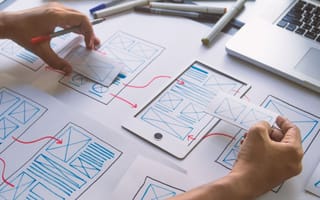The user journey from point A to point B shouldn’t be an epic voyage; it should be an unbothered jaunt. Frequently, however, users find themselves navigating illogical interfaces and overstuffed pages — and the decision to click the back button is easy.
Simplicity is key when it comes to building a user journey. Overly complex layouts and inconsistent experiences can drive customers away, opting for competitors with a more straightforward approach.
For designers, creating simple user journeys is an ongoing, purposeful process that demands restraint, analysis and empathy. In short, it takes a lot of work and attention to create effortless experiences.
“When users know it doesn’t take too long to accomplish a task — no guided tours — they’re more likely to use the app,” InspiringApps’ Art Director Aaron Lea explained. “A simple experience is a successful experience.”
Lea and GridX VP of Design, Galen Leith, chatted with Built In Colorado about how they devise and implement simple user journeys and shared common traps peers should watch for throughout their design processes.
Greentech company GridX provides utilities and energy companies with analytic insights on the cost of clean energy solutions.
When do you know it’s time to simplify your product’s user journey?
Product user journey simplification is a constant one — and rightly so. Simplification should be a consistent tug-of-war between what’s required on the front-end and what’s possible on the back-end, solid aspects of current designs and innovative future designs, and alignment of time and resources to specific problem areas or gaps. When a design practice is properly dialed into customers’ voices and utilizes the expertise in the product and engineering, ‘when’ to simplify is counterbalanced with the dependencies of ‘what’ and ‘how’.
In the context of a clean energy software start-up, we strive to make our broader journey more and more simple each sprint, because it lifts up every aspect of the business.
Simplification should be a consistent tug-of-war between what’s required on the front-end and what’s possible on the back-end.”
What process do you use to identify opportunities for simplification?
I have many examples of this process in practice.
Following a set of moderated user interviews on our core product, we saw and heard that customers were getting stuck on aspects of building segments and performing rate analysis. The problem with the current journey was that users needed to create a project before that kind of analysis could be performed. Creating a project, giving it a name, providing some level of detail and selecting data sets all before analysis could be performed, felt like building a box before knowing what to put in it.
Knowing our users repeat this step over and over, moving the create a project step further back in the journey stage would both reduce friction for quick, ad-hoc analysis, and reduce the number of random and cloned projects. Therefore, we drafted an updated flow and set of supporting interactions.
Now, one of the most powerful tools a design practice has is the ability to make something new and different very real. It draws attention to the vision by exposing differences between what could be and the current state. We love seeing the lights go off when showcasing a potential new UX!
What are some common traps designers can fall into that result in an overly complicated user journey?
The biggest trap I see designers fall into is making too many assumptions - and I don’t mean assumptions about our users. I mean assumptions that engineering will miraculously understand the importance of change, that product management will automatically prioritize innovative design work and that the broader organization and selling teams will translate increased value into the organization’s broader CX.
For a design practice to be successful and to lift the larger strategy of the business, understanding customers’ needs and behaviors is essential. But for the journey to be truly simple, it must balance users’ needs, business requirements and engineering capabilities. That requires UX and UI to work closely with product management and engineering end-to-end as part of an iterative process.

InspiringApps’ developers and designers help clients translate ideas into impactful multi-platform apps. The enterprise web company is one of Built In’s Best Places to Work in 2023.
When do you know it’s time to simplify your product’s user journey?
When we design digital apps, we’re always looking for ways to simplify the user journey. Limiting the number of interactions users have to make is a best practice for most apps. The more users have to drill down into extra screens, the more likely they are to leave.
I like to think of it this way: design the app like you’re in the Target parking lot and about to go inside the store to buy Tide Pods. As a user, I want to be in and out as quickly as possible. A quick exchange that’s easy for me to use means I’m more prone to open the app the next time I’m in that Target parking lot.
It’s often the case that apps are downloaded, opened once and then deleted. These apps are too cluttered, and people won’t reuse them. On the other hand, when users know it doesn’t take too long to accomplish a task — no guided tours — they’re more likely to use the app. A simple experience is a successful experience.
Unless we’re creating something like TikTok, we aren’t designing the app to keep users in it. We’re here to help users achieve something or access a specific feature. The fewer interactions it takes to accomplish that, the better the journey.
What process do you use to identify opportunities for simplification?
App design is an art that involves trusting your instincts. I like to think of this process as similar to editing a script. Editors are great at identifying what’s essential and getting rid of clutter. But their real goal is staying true to what makes the script great — and amplifying that by revealing only what needs to be there.
For example, an app may have a component that mirrors the functionality of Slack or Youtube. These are established popular apps. And even the best digital products aren’t going to lure people away from them.
Any project, whether it’s designing an app or a home improvement project, can be subject to scope creep. Is that feature really needed? Was it added at the last minute?
We all get distracted in the creative journey, and the risk is that we keep getting further away from — or even lose sight of — the reason we started, the problem we wanted to solve. We need to stay true to what inspired us in the beginning to create the app.
What are some common traps designers can fall into that result in an overly complicated user journey?
One trap is elevating ego over empathy. If the designer doesn’t remove themself and try to see the user’s perspective, they can overly complicate the journey. Designers must constantly evolve, challenge themselves and put themselves in others’ shoes.
If the designer doesn’t remove themself and try to see the user’s perspective, they can overly complicate the journey.”
Another trap could be the designer finding a new design tool or method they want to use and deciding to use it in a particular product. Novelty is not a substitute for suitability. A good rule of thumb is, don’t force it if it doesn’t deserve to be there.
Sometimes, designers get set in their ways. Just because it worked last time doesn’t mean it will work this time too. Or conversely, designers may reinvent the wheel. If the design worked the first time, there’s no need to rethink it.
Time management is critical. With mobile apps, people remember the launch, the middle, and the endpoint. A trap could be spending too much time on incidental interstitial areas. Don’t focus all your time there. Take that time and instead pick the three most vital sections — the app’s beginning, the middle and its exit — and make those experiences ones that keep users coming back.









